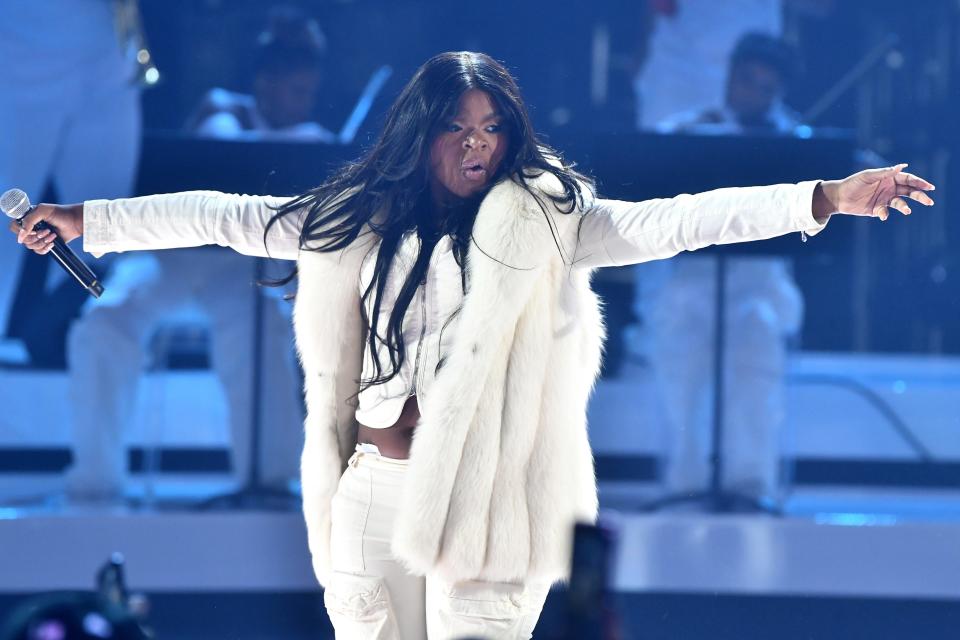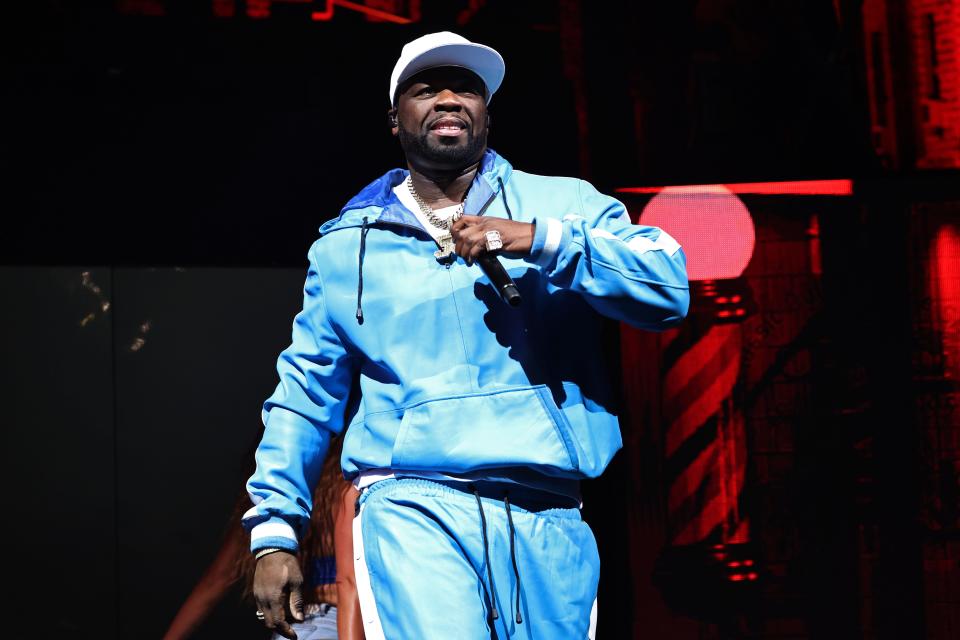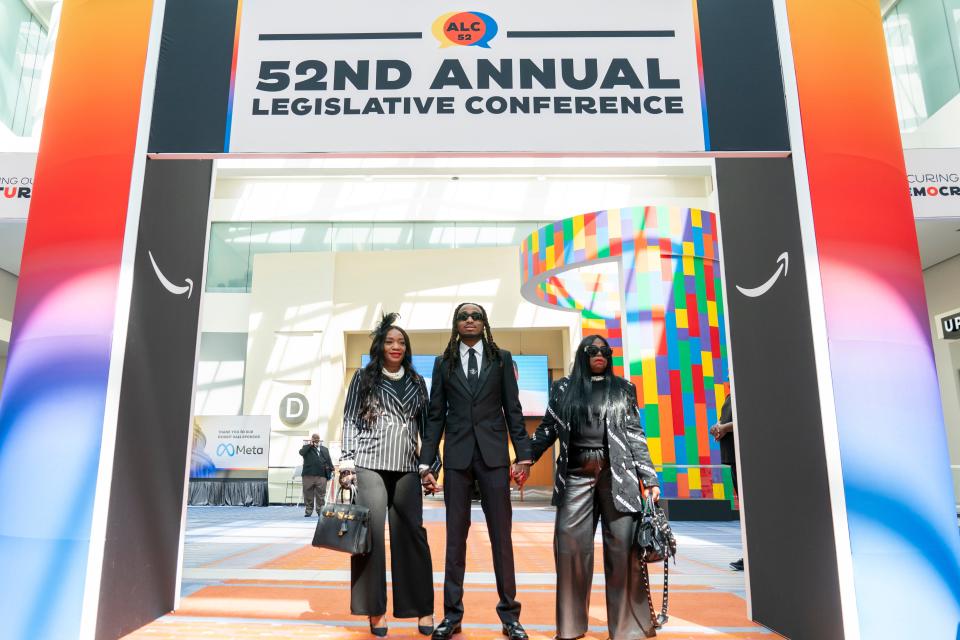50 Cent, ScarLip on hip-hop and violence stereotype: 'How about we look at society?'
Hip-hop's 50th anniversary went off without a hitch as Run-D.M.C. had their final performance in August at the Hip Hop 50 Live concert at Yankee Stadium. 50 Cent and Busta Rhymes celebrated future generations of rappers at 50 Cent's The Final Lap Tour and female MCs like Queen Latifah, Remy Ma and MC Lyte got their flowers in Netflix's "Ladies First: A Story of Women in Hip-Hop."
Rappers including 2Pac, Notorious B.I.G., Nipsey Hussle, Pop Smoke, Takeoff and more who died due to gun violence were incorporated into the celebrations despite their physical absence.
Pop Smoke was honored during 50 Cent's show in Brooklyn, New York, where the "Power" star performed their posthumous collaboration "The Woo." At Hip Hop 50 in New York, Wiz Khalifa performed "See You Again" as names and faces of fallen rappers flashed across the screen.
It may seem like a contradiction that in the same shows rappers memorialize their fallen peers, they also delivering lyrics about shooting rivals. While hip-hop continues to dominate streaming platforms and the charts, the negative association between rap and violence has not diminished. However, experts say the stigma surrounding graphic rap lyrics is misguided.
"No rapper has done more damage than the movie 'Scarface.' There’s no rapper that has done more damage than 'The Godfather' (and) 'Goodfellas,'" 50 Cent tells USA TODAY when discussing the connection between violence and hip-hop.
Like mafia movies, rap lyrics are born out of artistic expression mixed with reality. They are also used to cope with violence in communities caused by external factors like racism and poverty.
Cleaning up lyrics won't lessen violence without addressing the community's needs, experts say.
Rap lyrics make the same points as Ivy League sociologists

50 Cent – toured this year in celebration of the 20th anniversary of his debut album "Get Rich or Die Tryin'" – rapped about the struggles growing up in the Jamaica neighborhood of Queens, New York, his life as a "gangsta" and his trouble with law enforcement in his debut.
The album also emerged after he was shot nine times at close range in a near-fatal incident as part of a targeted attack. "Hommo shot me, three weeks later he got shot down," 50 Cent raps in "Many Men (Wish Death)," a reference to his alleged assailant Darryl "Hommo" Baum.
He follows in the footsteps of rappers who used their lyrics as a means to get out of their street environment and criticize systems of oppression.
"If this is violence, then violent's what I gotta be / If you investigate you'll find out where it's comin' from / Look through our history, America's the violent one," Shakur rapped in "Violent," addressing racial profiling. Years later, Jay-Z discussed systemic racism in "Hard Knock Life (Ghetto Anthem)," noting all the times people in poverty have been knocked down.
Charis E. Kubrin, a criminology professor at the University of California, Irvine, recalls reading works from theorists such as Harvard professor William Julius Wilson and Yale professor Elijah Anderson when she was getting her Ph.D. in sociology and noticed "social theories were mirrored in the lyrics of Biggie Smalls and Tupac and others. They were saying the same things, but just completely differently."
Why do hip-hop artists rap about violence?
What separates the outlook of these theorists and rappers is the messenger. The theorists are viewed as esteemed academics for people in higher education to learn from. In contrast, rap is looked at as a vehicle to encourage violent crime, experts say.
"We only rap what we've been through," says "This Is New York" rapper ScarLip. "When we rapping about guns, when we rapping about killers, when we rapping about all of these type of things … this is the environment that we've been placed in."

ScarLip, a 22-year-old talent who's adopted '90s style gangsta rap, says writing about violence, the foster care system and mental health in her music is "a healthy way to express myself."
"I come from the hood," she adds. "Growing up in the Bronx, New York, (and) dealing with a lot of trauma, abandonment issues, neglect and really not having an outlet to express myself … poetry literally saved my life."
The battle against drill in hip-hop
Some argue today's rap pushes the line between artistic expression and anarchy.
Drill – a rising subgenre of rap that originated in Chicago – fuzes the sound of trap music and the messages of gangsta rap.
In early February 2022, New York City Mayor Eric Adams wanted to remove drill music from X, formerly known as Twitter, citing it as the cause of violent crime. "We pulled Trump off Twitter … yet we are allowing music displaying of guns, violence," he said at a press conference.
Adams later met with rappers to discuss the topic. Brooklyn artist Maino, who led the discussion, told NY1 he clarified to Adams that drill "is a sound and not an action."
Maino, 50, said many teenage drill rappers were involved in gang violence prior to getting into music. But the root of the problem has always been a result of poverty, he said.
"Thirty years ago, it was gangster rap, now it is drill rap. It's the same problem until we have set out some real initiatives and some plans to actually address prevention," Maino said, referring to at-risk youth from "underfunded communities and broken homes" attracted to "the gang life and street life."
50 Cent, an executive producer on the "Hip Hop Homicides" docuseries, questioned the message of drill. "There's certain segments of hip-hop culture that are more aggressive, more violent. Drill music is like that," he says.
The rapper initially believed, similarly to Adams, that drill is closely related to a confession. What he's learned from kids and teens in his old neighborhood is that drill is a form of expression to make rival groups "feel the way they felt when they lost a loved one."
50 Cent used to taunt his rivals and law enforcement in his songs. "The DA can play this (expletive) tape in court / I'll kill you, I ain't playin'," he rapped in "Heat."
It wasn't a confession, and lyrics aren't always biographical. "I said that as a 'Oh, he don’t care at all.' That energy. But, I would never do that," 50 Cent asserts.

"Some of us are rapping what we around," ScarLip says, noting rapping is a safer release. "(Would you) rather us rap about it or rather us go out there and do things like that?"
50 Cent, Busta Rhymes celebrate generations of rappers ahead of hip-hop's milestone anniversary
Understanding hip-hop: 'Music is storytelling and no one can tell my story better than me'
Combatting bias against rap music is not about changing its content, it's about perception, experts say.
Hip-hop is still in its youth compared to other genres, and many younger generations do not have the same prejudice against it as older generations who did not grow up with it, Kubrin's study determined.
Kubrin compares seeing a horror movie for the first time without realizing a "good horror film" includes violence, gore and suspense can be applied to listening to hip-hop without knowing the full story.
California state Rep. Reggie Jones-Sawyer, who introduced the now-passed Decriminalizing Artistic Expression Act in California in last year, says he was approached by Recording Academy CEO Harvey Mason Jr. to protect art through legislation.
The bill calls on courtrooms seeking to use "artistic expression" such as lyrics as evidence to have more substantial evidence, testimony from an expert in that genre of artistic expression, or additional research of how it could introduce racial bias to the case.
It was the first passed U.S. bill of its kind, followed by Louisiana earlier this year. Illinois, New Jersey, New York, Missouri and Maryland have introduced similar bills.
Jones-Sawyer says the legislation is helpful across all genres and arts fields.
In September, Quavo, who lost fellow Migos member Takeoff to gun violence last year, met with members of Congress in Washington, DC for a panel discussion on gun violence prevention led by Georgia Senator Reverend Raphael Warnock.

The panel discussed community intervention strategies and the power of music and culture in anti-gun violence advocacy.
“Music is storytelling and no one can tell my story better than me. For me and my family, the fight against gun violence is personal and not something we are going to forget,” Quavo said in a statement to CNN.
“Together, with solutions that come straight from my heart and our neighborhoods, we can tackle this violence head-on and save lives,” the Georgia-born rapper said.
Rap is an art form like any other. As the 50th anniversary celebrations come to an end, the history of the genre as a medium to overcome violence should also be praised.
The means of therapeutic expression isn't perfect, but that's OK. It's a reflection of life.
"Instead of judging us and trying to criticize us, how about we look at society and be like, well, 'What would make a young Black man or a young Black girl, rap about something like that?'" ScarLip says, referencing her own lyrics: "I don’t wanna smile … I wanna cry."
Run-D.M.C. performs for final time, Snoop Dogg, Nas, hip-hop icons celebrate 50 years with blowout bash
This article originally appeared on USA TODAY: 50 Cent, ScarLip, experts dismantle hip-hop and violence stereotypes
